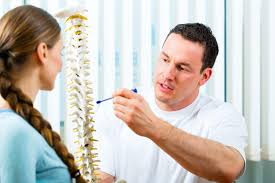The narrowing of the spaces within your spine which can put pressure on the nerves that travel through there is known as spinal stenosis. This malady occurs most often in the lower back and the neck region. Usually spinal stenosis is caused by wear-and-tear changes in the spine related to osteoarthritis. Doctors may recommend surgery to create additional space for the spinal cord or nerves in severe cases of spinal stenosis.
While some sufferers may experience pain, tingling, numbness and muscle weakness that can worsen over time, some people with spinal stenosis may not have symptoms. A number of people are born with a small spinal canal and this is called “congenital stenosis”. In most cases,though, spinal narrowing is due to age-related changes that take place over time, and this is called “acquired spinal stenosis.”
Your risk of developing spinal stenosis increases if you are female, were born with a narrow spinal canal, are 50 years old or older or if you have had a previous injury or surgery of the spine. There are certain medical conditions which can cause spinal stenosis including Paget’s Disease, spinal tumors, inflammatory spondyloarthritis and osteoarthritis, as well as bony spurs that form as we age.
A rheumatologist will ask about your symptoms and medical history. If he suspects spinal stenosis he will do a physical exam and some symptoms he will look for include numbness, weakness, cramping or pain in the legs, thighs or feet that makes it hard to walk, as well as pain that goes down the leg. He may also want to know about any abnormal bowel and/or bladder function and loss of sexual function. There may even be, in severe cases, partial or complete leg paralysis. This is considered a medical emergency and he would likely instruct you to get to an emergency room as quickly as possible.
The location of the stenosis and the severity of your signs and symptoms will determine your treatment for spinal stenosis. Consult with your doctor about the treatment that is best for your situation. In the event that your symptoms are mild or you are not experiencing any your doctor may monitor your condition with regular follow-up appointments. Your health care provider may offer some self-care tips that you can do at home. Further treatments may be required if these do not help, in such a case your doctor may recommend medications or physical therapy.
If other treatments have not helped surgery may be an option. A number of recent studies have found that surgery produces better results than non-surgical treatment in the short term. Although surgery may bring some relief, it will not cure spinal stenosis or osteoarthritis and it is possible that your symptoms may recur.
Medications may be needed to treat your condition, and your doctor may prescribe pain relievers. Ibuprofen (Advil, Motrin IB, others) and pain medications such as naproxen (Aleve, others) and acetaminophen (Tylenol, others) may be used temporarily to ease the discomfort of spinal stenosis. There is little evidence of benefit from long-term use of these medicines, so they are typically recommended for a short time only. Daily doses of tricyclic antidepressants, such as amitriptyline, can help ease chronic pain. Habit-forming medications that contain codeine-related drugs such as oxycodone (Oxycontin, Roxicodone) and hydrocodone (Norco, Vicodin) may be useful for short-term pain relief, but these opioids may also be considered cautiously for long-term treatment. Or your doctor may prescribe anti-seizure drugs, such as gabapentin (Neurontin) and pregabalin (Lyrica), which are used to reduce pain caused by damaged nerves.
In an effort to reduce pain it is common for people who have spinal stenosis to become less active. However, this can lead to muscle weakness, which can result in more pain. The services of a physical therapist may be called for. Your physical therapist can teach you exercises that may help you improve your balance, maintain the flexibility and stability of your spine and build up your strength and endurance. A physical therapist can help you build and maintain strength in the muscles of your arms and upper legs, which will improve your balance and ability to walk. This could also help you bend and move about, as well as control pain.








